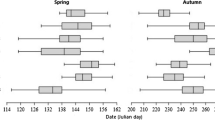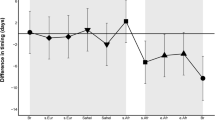Abstract
This study aims to investigate causes and mechanisms controlling protandrous migration patterns (the earlier breeding area arrival of males relative to females) and inter-sexual differences in timing of migration in relation to the recent climate-driven changes in phenology. Using standardised ringing data from a single site for eight North European migratory passerines collected throughout 22 years, we analysed sex-differentiated migration patterns, protandry and phenology of the entire populations. Our results show protandrous patterns for the first as well as later arriving individuals for all studied species. Males show more synchronous migration patterns compared to females and, hence, first arriving females followed males more closely than later arriving individuals. However, we found no inter-sexual differences in arrival trends as both sexes advance spring arrival over time with the largest change for the first arriving individuals. These findings seem in support of the “mate opportunity” hypothesis, as the arrival of males and females is strongly coupled and both sexes seem to compete for early arrival. Changes in timing of arrival in males and females as a response to climatic changes may influence subsequent mating decisions, with subsequent feedbacks on population dynamics such as reproductive success and individual fitness. However, during decades of consistent earlier spring arrival in all phases of migration we found no evidence of inter-sexual phenological differences.


Similar content being viewed by others
References
Ahola M, Laaksonen T, Sippola K, Eeva T, Rainio K, Lehikoinen E (2004) Variation in climate warming along the migration route uncouples arrival and breeding dates. Glob Change Biol 10:1610–1617
Bairlein F, Winkel W (2001) Birds and climate chance. In: Lozan JL, Grassl H, Hupfer P (eds) Climate of the 21st century: changes and risks. Scientific Facts, GEO, pp 278–282
Catry P, Campos A, Almada V, Cresswell W (2004) Winter segregation of migrant European robins Erithacus rubecula in relation to sex, age and size. J Avian Biol 35:204–209
Catry P, Lecoq M, Araújo A, Conway G, Felgueiras M, King MB, Rumsey S, Salima H, Tenreiro P (2005) Differential migration of chiffchaffs Phylloscopus collybita and P. ibericus in Europe and Africa. J Avian Biol 36:184–190
Coppack T, Tøttrup AP, Spottiswoode C (2006) Degree of protandry reflects level of extrapair paternity in migratory songbirds. J Ornithol 147:260–265
Francis CM, Cooke F (1986) Differential timing of spring migration in wood warblers (Parulinae). Auk 103:548–556
Francis CM, Cooke F (1990) Differential timing of spring migration in rose-breasted grosbeaks. J Field Ornithol 61:404–412
Grewal PS, Selvan S, Lewis EE, Gaugler R (1993) Male insect-parasitic nematodes—a colonizing sex. Experientia 49:605–608
Gunnarsson B, Johnsson J (1990) Protandry and molting to maturity in the spider Pityohyphantes phrygianus. Oikos 59:205–212
Hasselquist D (1998) Polygyny in great reed warblers: a long-term study of factors contributing to male fitness. Ecology 79:2376–2390
Jonzen N, Linden A, Ergon T, Knudsen E, Vik JO, Rubolini D, Piacentini D, Brinch C, Spina F, Karlsson L, Stervander M, Andersson A, Waldenstrom J, Lehikoinen A, Edvardsen E, Solvang R, Stenseth NC (2006) Rapid advance of spring arrival dates in long-distance migratory birds. Science 312:1959–1961
Ketterson ED, Nolan V (1976) Geographic variation and its climatic correlates in sex-ratio of eastern-wintering dark-eyed Juncos (Junco hyemalis Hyemalis). Ecology 57:679–693
Kokko H (1999) Competition for early arrival in migratory birds. J Anim Ecol 68:940–950
Kokko H, Gunnarsson TG, Morrell LJ, Gill JA (2006) Why do female migratory birds arrive later than males? J Anim Ecol 75:1293–1303
Komar O, O’Shea BJ, Peterson AT, Navarro-Siguenza AG (2005) Evidence of latitudinal sexual segregation among migratory birds wintering in Mexico. Auk 122:938–948
Lehikoinen E, Sparks TH, Zalakevicius M (2004) Arrival and departure dates. In: Møller AP, Fiedler W, Berthold P (eds) Birds and climate change. Elsevier, Oxford, pp 1–31
Michener GR (1983) Spring emergence schedules and vernal behaviour of Richardson’s ground squirrels: why do males emerge from hibernation before females? Behav Ecol Sociobiol 14:29–38
Morbey Y (2000) Protandry in Pacific salmon. Can J Fish Aquat Sci 57:1252–1257
Morbey YE, Ydenberg RC (2001) Protandrous arrival timing to breeding areas: a review. Ecol Lett 4:663–673
Myers JP (1981) A test of three hypotheses for latitudinal segregation of the sexes in wintering birds. Can J Zool 59:1527–1534
Otahal CD (1995) Sexual differences in Wilson Warbler migration. J Field Ornithol 66:60–69
Quader S (2005) Mate choice and its implications for conservation and management. Curr Sci 89:1220–1229
Rabøl J, Rahbek C (2002) Population trends in the Baltic passerine migrants, elucidated by a combination of ringing data and point- and summer-count indices. Dansk Ornitol Foren Tidsskr 96:15–38
Rainio K, Laaksonen T, Ahola M, Vahatalo AV, Lehikoinen E (2006) Climatic responses in spring migration of boreal and arctic birds in relation to wintering area and taxonomy. J Avian Biol 37:507–515
Rainio K, Tøttrup AP, Lehikoinen E, Coppack T (2007) Has climate change affected the degree of protandry in migratory songbirds? Climate Research (in press)
Rubolini D, Spina F, Saino N (2004) Protandry and sexual dimorphism in trans-Saharan migratory birds. Behav Ecol 15:592–601
Spottiswoode C, Tøttrup AP, Coppack T (2006) Sexual selection predicts advancement of avian spring migration in response to climate change. Proc R Soc Lond B 273:3023–3029
Thornhill R, Alcock J (1983) The evolution of insect mating systems. Harvard University Press, Cambridge, Mass
Thorup K, Tøttrup AP, Rahbek C (2007) Patterns of phenological changes in migratory birds. Oecologia 151:697–703
Tøttrup AP, Thorup K, Rahbek C (2006a) Changes in timing of autumn migration in North European songbird populations. Ardea 94:527–536
Tøttrup AP, Thorup K, Rahbek C (2006b) Patterns of change in timing of spring migration in North European songbird populations. J Avian Biol 37:84–92
Wang G, Greenfield MD, Shelly TE (1990) Inter-male competition for high-quality host-plants: the evolution of protandry in a territorial grasshopper. Behav Ecol Sociobiol 27:191–198
Acknowledgments
We wish to thank the numerous ringers collecting the data, and J. M. Lausten, P. Lyngs, J. Rabøl as well as Christiansø Research Station for ensuring the high data quality. An anonymous referee provided useful comments improving the manuscript. The Danish National and Nature Agency and The National Environmental Research Institute financed the data collection.
Author information
Authors and Affiliations
Corresponding author
Additional information
Communicated by F. Bairlein.
Rights and permissions
About this article
Cite this article
Tøttrup, A.P., Thorup, K. Sex-differentiated migration patterns, protandry and phenology in North European songbird populations. J Ornithol 149, 161–167 (2008). https://doi.org/10.1007/s10336-007-0254-x
Received:
Revised:
Accepted:
Published:
Issue Date:
DOI: https://doi.org/10.1007/s10336-007-0254-x




